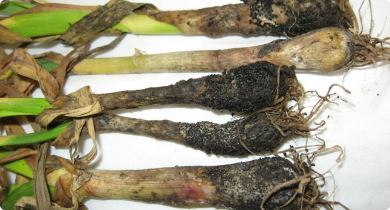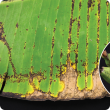Fungi
Fungi are eukaryotic (membrane bound nucleus) organisms that develop from reproductive bodies called spores. They can cause a number of diseases in animals and plants. As a disease of plants and animals, fungi are a risk for Western Australian primary producers as they impact upon market access and agricultural production.
WA is free from some of the world's major fungal diseases. Biosecurity measures on your property are vital in preventing the spread of fungal diseases.
The Department of Primary Industries and Regional Development provides:
- biosecurity/quarantine measures at the WA border to prevent the entry of fungal diseases.
- where relevant post border biosecurity measures.
- advice on widespread fungal diseases present in the state.
For advice on fungal diseases search our website, the Western Australian Organism List or contact our Pest and Disease Information Service (PaDIS).
For diagnostic services, please contact our Diagnostic Laboratory Services.
Filter by search
Filter by topic
- (-) Remove Horticulture filter Horticulture
- Crops (38) Apply Crops filter
- Fruit (16) Apply Fruit filter
- Plant biosecurity (15) Apply Plant biosecurity filter
- Biosecurity (15) Apply Biosecurity filter
- Biosecurity & quarantine (15) Apply Biosecurity & quarantine filter
- Vegetables (10) Apply Vegetables filter
- Grapes & wine (9) Apply Grapes & wine filter
- Citrus (8) Apply Citrus filter
- Table grapes (8) Apply Table grapes filter
- Wine grapes (7) Apply Wine grapes filter
- Nursery & cutflowers (6) Apply Nursery & cutflowers filter
- Crop diseases (3) Apply Crop diseases filter
- Onions (3) Apply Onions filter
- Strawberries (3) Apply Strawberries filter
- Chinese cabbage (3) Apply Chinese cabbage filter
- Cauliflower (3) Apply Cauliflower filter
- Broccoli (3) Apply Broccoli filter
- Brussels sprouts (3) Apply Brussels sprouts filter
- Cabbage (3) Apply Cabbage filter
- Minor fruits (2) Apply Minor fruits filter
- Garlic (2) Apply Garlic filter
- Potatoes (2) Apply Potatoes filter
- Carrots (2) Apply Carrots filter
- Bananas (2) Apply Bananas filter
- Pome fruit (1) Apply Pome fruit filter
- Tomatoes (1) Apply Tomatoes filter
- Olives (1) Apply Olives filter
- Quarantine (1) Apply Quarantine filter
- Leeks (1) Apply Leeks filter
- Bacteria (1) Apply Bacteria filter
- Capsicums and chillies (1) Apply Capsicums and chillies filter
- Control methods (1) Apply Control methods filter
- New horticulture crops (1) Apply New horticulture crops filter





